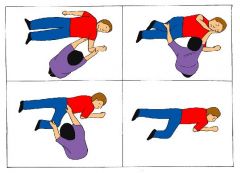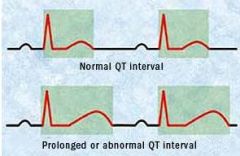![]()
![]()
![]()
Use LEFT and RIGHT arrow keys to navigate between flashcards;
Use UP and DOWN arrow keys to flip the card;
H to show hint;
A reads text to speech;
25 Cards in this Set
- Front
- Back
|
If suspect person not breathing, how long should you check for pulse?
|
≤10 sec
|
|
|
When checking for a pulse, where should you palpate in an adult, child, and infant?
|
carotid in adult
carotid or femoral in child brachial in infant |
|
|
When giving CPR to an adult, how many compression and breaths per cycle?
|
30 compression followed by 2 breaths
|
|
|
What is recovering position?
|

|
|
|
If STEMI, within what time frame should PCI or fibrinolytic therapy be initiated?
|
PCI within 90 minutes or fibrinolytic therapy within 30 minutes only if <12 hours within onset of symptoms
|
|
|
What is the clinical presentation that represents a high likelihood of ACS secondary for CAD?
|
chest or LT arm pain or discomfort reproducing prior documented angina, known hx of CAD (including MI), hypotension, diaphoresis, transient MR murmur, rales, pulmonary edema, transient ST-segment deviation or T-wave inversion in multiple precordial leads, elevated cardiac enzymes (trop, ckmb)
|
|
|
What is the clinical presentation of intermediate likelihood of ACS secondary to CAD?
|
chest or LT arm pain or discomfort, >70y/o, male, DM, extracardiac vascular disease, fixed Q waves, ST depression or T wave inversion, normal cardiac markers
|
|
|
What is the clinical presentation of low likelihood of ACS secondary to CAD?
|
probable ischemic sxs in absence of any intermediate-likelihood characteristics, recent cocaine use, chest discomfort on palpation, T wave flattening or inversion in leads with dominant R waves, normal EKG and cardiac markers
|
|
|
If pulse present, but breathing absent, how often should breaths be given?
|
1 breath every 5-6 seconds for adults
1 breath every 3-5 seconds for children or infants recheck pulse every 2 minutes |
|
|
Describe the fibrinolytic checklist for STEMI.
|
Chest discomfort >15 min but <12 hours
STEMI or new LBBB No contraindications Systolic BP >180 or diastolic >100 RT vs LT arm systolic BP difference >15 mmHg Hx of Structural CNS dz Significant closed head/facial trauma within past 3 weeks Stroke >3 hours or <3 months Major trauma or surgery or GI/GU bleed in past 2-4 weeks Hx of intercranial hemorrhage Bleeding or clotting problems Blood thinners Pregnancy Serious systemic disease (advanced cancer, severe liver or kidney dz) No high risk factors HR ≥100 + systolic BP <100 Pulmonary edema (rales) Signs of shock (cool, clammy) Required CPR |
|
|
What are the indications for naloxone?
|
reverse effects of narcotic toxicity
|
|
|
What are the indications for nitroglycerin?
|
ischemic chest pain
HF (especially associated with myocardial ischemia) hypertensive emergency pulmonary HTN |
|
|
What are the indications for furosemide?
|
acute pulmonary edema
hypertensive emergency |
|
|
What are the indications for morphine?
|
ischemic chest pain refractory to nitroglycerin
acute cardiogenic pulmonary edema if BP adequate |
|
|
What are the indications for calcium chloride?
|
hypocalcemia
hyperkalemia hypermagnesemia CCB overdose |
|
|
What are the indications for heparin?
|
ACS (especially unstable angina or NSTEMI)
|
|
|
What are the indications for captopril?
|
ACE inhibitor given <24 hours post-MI
|
|
|
What are the indications for aspirin?
|
ischemic chest pain
|
|
|
What are the indications for atropine?
|
1st line for bradycardia
|
|
|
What are the indications for epinephrine?
|
pulseless ventricular tachycardia
ventricular fibrillation pulseless electrical activity asystole give 1 mg every 3 minutes if unresponsive to shock/CPR |
|
|
What are the indications for vasopressin?
|
may be substituted for epinephrine
|
|
|
What are the indications for sodium bicarbonate?
|
-known pre-existing hyperkalemia
-known pre-existing bicarbonate-responsive acidosis (diabetic ketoacidosis, overdose of aspirin, diphenhydramine, tricyclic antidepressants, cocaine) -prolonged resuscitation with effective ventilation |
|
|
What are the indications for dopamine/doputamine?
|
2nd line for bradycardia
SBP <100 with sxs of shock |
|
|
What is the length of a prolonged QT interval?
|

>.44 seconds
|
|
|
What are the indications for diazepam?
|
sedation before cardioversion
|

